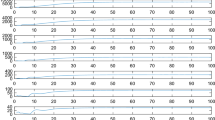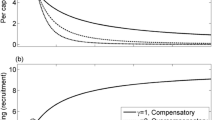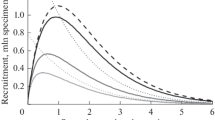Abstract
A two-dimensional stage-structured population model with nonlinear cannibalism terms is studied. We show that there is a large parameter interval where the nontrivial equilibrium of the model is the only stable attractor, but that there also exist parameter intervals where we find quasiperiodic, periodic and chaotic dynamics. Moreover, in the interplay between increasing the fecundity and increasing the cannibalism pressure, the former turns out to be a destabilizing effect while the latter tends to act in a stabilizing fashion. Finally, we have applied the model to the North Atlantic cod stock using ICES biomass estimates. Our main conclusion from this study is that the combined effect of recruitment and cannibalism may not serve as an explanation of the observed fluctuations in the cod stock.
Similar content being viewed by others
References
Anon (2001). Advisory Committee on Fisheries Management (ACFM): Report of the Arctic fisheries Working Group. ICES CM 2001/ACFM:19.
Bogstad, B., G. R. Lilly, S. Mehl, Ó. K. Pálsson and G. Stefánsson (1994). Cannibalism and year-class strength in Atlantic cod (Gadus morhua) in Arcto-boreal ecosystems (Barents Sea, Iceland, and eastern Newfoundland). ICES Mar. Sci. Symp. 198, 576–599.
Caswell, H. (2001). Matrix Population Models, Sunderland, Massachusetts: Sinauer Ass. Inc. Publishers.
Costantino, R. F., R. A. Deshamais, J. M. Cushing and B. Dennis (1997). Chaotic dynamics in an insect population. Science 275, 389–391.
Cushing, J. M., R. F. Costantino, B. Dennis, R. A. Deshamais and S. M. Henson (1998). Nonlinear population dynamics: models experiments and data. J. Theor. Biol. 194, 1–9.
Cushing, J. M., B. Dennis, R. A. Deshamais and R. F. Costantino (1996). An interdisciplinary approach to understanding nonlinear ecological dynamics. Ecol. Model 92, 111–119.
Dennis, B., R. A. Deshamais, J. M. Cushing and R. F. Costantino (1997). Transition in population dynamics: equilibria to periodic cycles to aperiodic cycles. J. Anim. Ecol. 6b, 704–729.
Fox, L. R. (1975). Cannibalism in natural populations. Ann. Rev. Ecol. Syst. 6, 87–106.
Guckenheimer, J. and P. Holmes (1990). Nonlinear Oscillations, Dynamical Systems and Bifurcations of Vector Fields, Berlin, Heidelberg, New York, Tokyo: Springer Verlag.
Hjort, J. (1914). Fluctuations in the great fisheries of Northern Europe, in Const. Int. Explor.-Mer., Copenhagen.
Jørgensen, T. (1992). Long-term changes in growth of North-east Arctic cod (Gadus morhua) and some environmental influences. ICES J. Mar. Sci. 49, 263–277.
Levin, S. A. (1981). Age-structure and stability in multiple-age spawning populations, in Renewable Resource Managements, T. L. Vincent and J. M. Skowronski (Eds), Heidelberg: Springer Verlag.
Levin, S. A. and P. H. Goodyear (1980). Analysis of an age-structured fishery model. J. Math. Biol. 9, 245–274.
Linehan, J. E., R. S. Gregpry and D. C. Schneider (2001). Predation risk of age-0 cod (Gadus) relative to depth and substrate in coastal waters. J. Exp. Mar. Biol. Ecol. 263, 25–44.
Murray, J. D. (1993). Mathematical Biology, 2nd edn corrected, Berlin, Heidelberg, New York: Springer.
Myers R. A., W. Blanchard, K. R. Thompson, 1990. Summary of North Atlantic fish recruitment 1942–1987. Can. Tech. Rep. Fish. & Aquat. Sci. 1743.
Ottersen, G. (1996). Environmental impact on variability in recruitment, larval growth and distribution of Arcto-Norwegian cod, Dr Scient thesis, Geophysical Institute, University of Bergen.
Polis, G. A. (1981). The evolution and dynamics of intraspecific predation. Ann. Rev. Ecol. Syst. 12, 225–251.
Ricker, W. E. (1954). Stock and recruitment. J. Fish. Res. Board Can. 11, 559–623.
Tjelmeland, S. and B. Bogstad (1998a). Biological modelling, in Models for Multispecies Management, T. Rødseth (Ed.), Heidelberg, New York: Physica, pp. 69–91.
Tjelmeland, S. and B. Bogstad (1998b). MULTSPEC—a review of a multispecies modelling project for the Barents Sea. Fisheries Research. 37, Elsevier, pp. 127–142.
Wikan, A. and E. Mjølhus (1996). Overcompensatory recruitment and generation delay in discrete age-structured population models. J. Math. Biol. 35, 195–239.
Author information
Authors and Affiliations
Corresponding author
Rights and permissions
About this article
Cite this article
Wikan, A., Eide, A. An analysis of a nonlinear stage-structured cannibalism model with application to the Northeast Arctic cod stock. Bull. Math. Biol. 66, 1685–1704 (2004). https://doi.org/10.1016/j.bulm.2004.03.005
Received:
Accepted:
Issue Date:
DOI: https://doi.org/10.1016/j.bulm.2004.03.005




